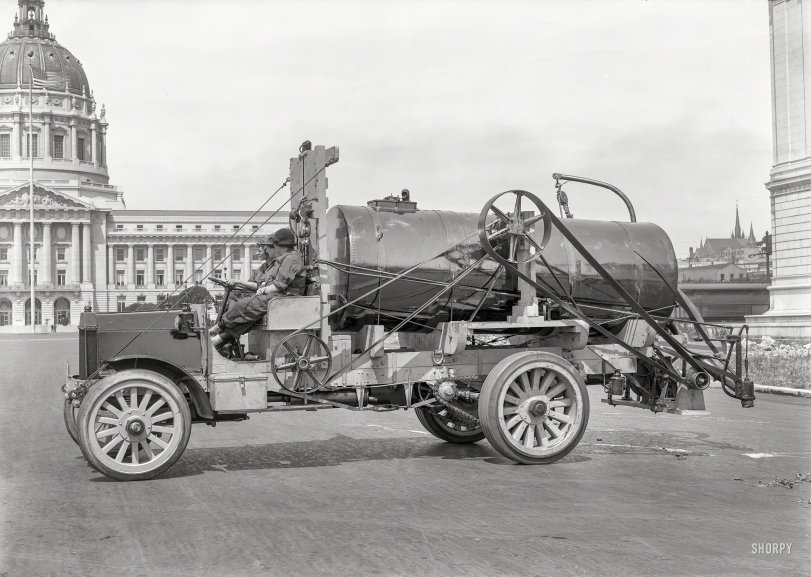


Framed or unframed, desk size to sofa size, printed by us in Arizona and Alabama since 2007. Explore now.
Shorpy is funded by you. Patreon contributors get an ad-free experience.
Learn more.

- Details, Details
- What's that building to the left of the tower?
- Coal Barges
- Bromo-Seltzer
- Inner harbor
- The Basin
- What a headache!
- Giant stepladder?
- Baldwin 62303
- Baldwin VO-1000
- Cold
- No expense spared
- Tough Guys
- Lost in Toyland
- And without gloves
- If I were a blindfolded time traveler
- Smoke Consumer Also Cooks
- Oh that stove!
- Possibly still there?
- What?!?
- $100 Reward
- Freeze Frame
- Texas Flyer wanted
- Just a Year Too Soon
- WWII -- Replacing men with women at the railroad crossing.
- Yes, Icing
- You kids drive me nuts!
- NOT An Easy Job
- I wonder
- Just add window boxes
Print Emporium
Approach With Caution: 1919

San Francisco City Hall circa 1919. "Peerless truck." Three young ladies aboard what seems to be some sort of street-cleaning, finger-ripping machine. Hide your children and stand clear! 5x7 glass negative by Christopher Helin. View full size.
Unsightly Limbs and Appendages
...Removed While You Wait! Just step a little closer, please.
Crew
The third crew member is the flight engineer.
You can't make this up
Thanks to Jim Page for informing us "Here we see a 1918 Peerless Isadora-model Pinchmaster 3000 truck". "Pinchmaster", could there be a more appropriate name of it than that?
[Jim did make that up. The reference to Isadora Duncan was especially sly. - Dave]
Hey Honey
This truck looks a heck of a lot like a "honey dipper" to me. Other than the 1919 running gear and mechanism, they still look like that today.
[Like our previous street flusher, this rig was one of many deployed as a public-health measure during the flu epidemic of 1918-1920 to control dust. - Dave]
The three P's
Peerless, Packard and Pierce Arrow were makers of some of the best cars and trucks of their era. Chain drive has its advantages: (1) less unsprung weight; (2) ease of gear ratio change; (3) lack of rear wheel spin in soft ground; (4) great sound going down the road.
Vehicle ID
I usually allow others to handle the vehicle ID chores here at Shorpy, but since no one has stepped up: Here we see a 1918 Peerless Isadora-model Pinchmaster 3000 truck. Few were made, as this model required a three-person crew, and the replacement 1919 Peerless Fargo-model Chopmaster 4000 only required a crew of two-and-a-half (two in a pinch).
Original power washer
Belt driven PTO runs the rear mounted pump. Two control levers by the closest operator regulate how much flow is produced to swish the road apples to the gutter.
Street Cleaner??
It looks more like the kind of equipment that would be used to spread liquid asphalt (aka tar) on a roadway before spreading a layer of stone on it. Admittedly, it's very clean, so this might have been a publicity shot for the manunfacturers. "So simple the ladies can operate it!"
Wowser
Definitely high tech for its day. The belt drives appear to be increasing the speed to a (pump?) under the end of the tank. I can't see any spray nozzles so I would assume it's used to refill the tank?
Pilot for short subject series
I believe this is a still from "The Three Stoogettes", an unsold movie short series which was way ahead of its time -- "We'll clean your sheets, we'll clean your streets, in half the time, no more grime ... zots!"
Count your fingers
I trust those open belt and chain drives are OSHA approved. But I bet it was more interesting when you could see the parts of machinery doing their thing.
Tot-Twirler
When I see gear like this, I'm just going to start labeling it "babyshredder."
The third operator was necessary for when the first two inevitably got caught in the machinery.
More Danger Lurking
And if you do get passed the hair pulling - finger ripping apparatus, there's always that two foot section of lead pipe on the floor to worry about.
Goldbergian
In 1904, freshly minted from the UC-Berkeley Engineering School, Rube Goldberg took a job with the San Francisco Department of Water and Sewers. Although he left in a few months to be a cartoonist for the SF Chronicle, it appears he kept his hand in by designing machines for the Department.
Safety guards ! Safety guards!
We don't need no steenking safety guards!
Awesome
I just stumbled upon this site. I love vintage photos, and this one is terrific -- who knew that there were women filling roles like this in the early 20th Century?
Finger ripping is putting it mildy.
That truck looks as if it was designed to inflict injury. I hope those women got hazardous duty pay.
Crazy Contraptions
I think if Rube Goldberg had ever designed a truck, it would look just like that.
Before Rosie the Riveter
I love showing people these sorts of images, in light of the fact that most of our images of American Women in Action come from the WWII era, where they were pressed into service because men had gone to war. These ladies, in 1919, look like they just ... have jobs. I love the proto-Rosie coveralls and headscarves, the likes which show up again a scant fifteen years later as something unusual in "The Saturday Evening Post" and LIFE magazines.
Frightening
The single most dangerous street machine I have ever seen.
























On Shorpy:
Today’s Top 5